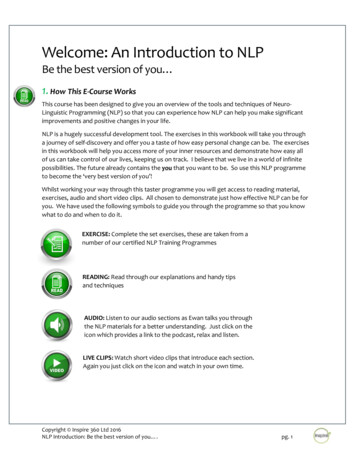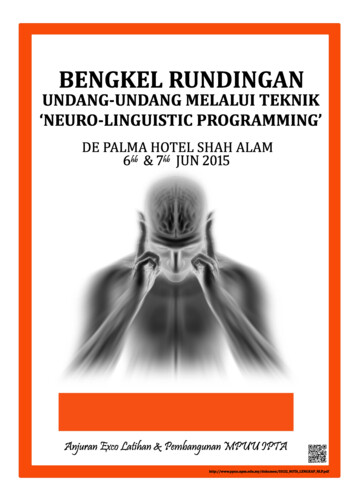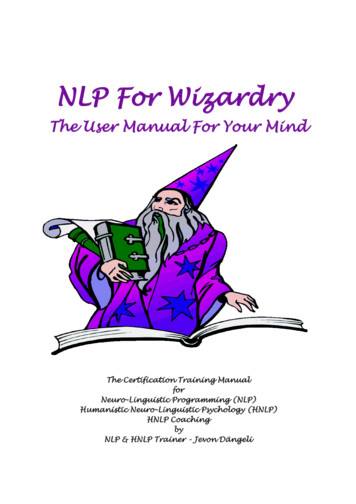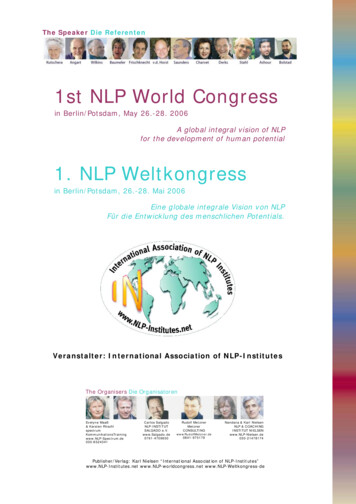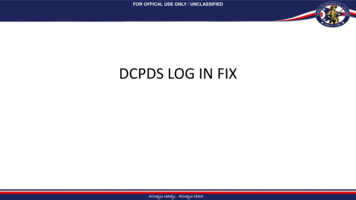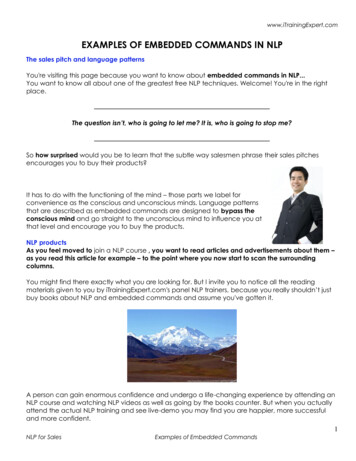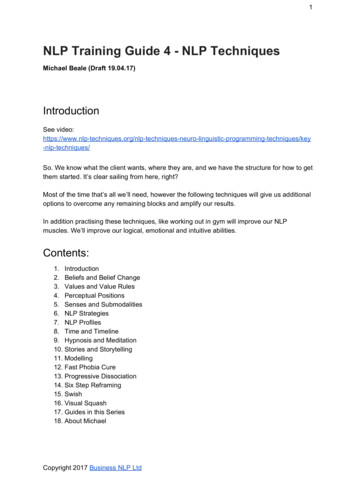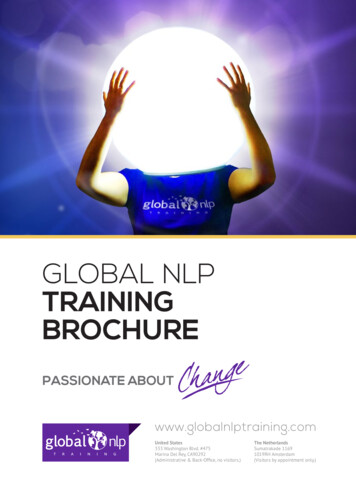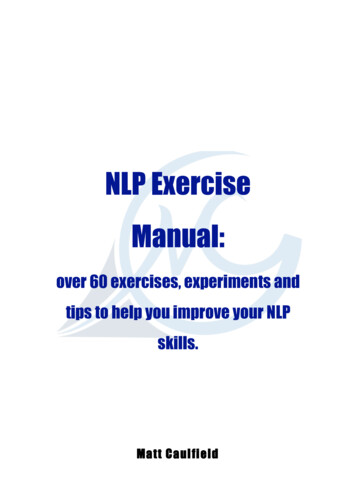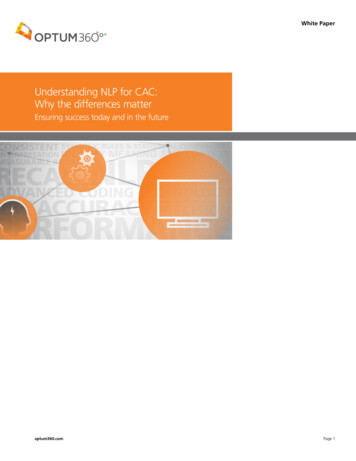
Transcription
White PaperUnderstanding NLP for CAC:Why the differences matterEnsuring success today and in the futureoptum360.comPage 1
Understanding NLP for CACPerformance perspectivesHealth care financial leaders and health information management (HIM) professionals havea shared concern: They are looking for the best, most efficient means to safeguard revenueand continue to advance medical coding following the transition to the ICD-10-CM/PCScode set, ensuring revenue integrity and maintaining coding productivity and accuracy.For the industry as whole, ICD-10 implementation has been reasonably smooth withinvestments in training, technology and testing paying off. The expansion to approximately155,000 diagnosis and procedure codes available in ICD-10, versus only about 17,000 inICD-9, and pressure to handle the change from fee-for-service to fee-for-value are drivingthe advancement of technology in the HIM space and overall revenue cycle operations.In this rapidly changing environment, provider organizations have adopted computerassisted coding (CAC) powered by natural language processing (NLP). CAC is becoming thenew infrastructure for the middle of the revenue cycle, and leaders are looking forward tooptimizing their current systems and contemplating replacing those that have not deliveredon promised results.CAC, or the use of computer software that automatically generates a set of medical codesfor review, validation and use based upon clinical documentation, has moved beyondthe early adopter stage, becoming a valuable tool utilized in hospitals, surgery centersand clinics across the United States. In these health care settings, CAC has enabledimprovements in important technical and business performance measures, includingimproved efficiency and accuracy from coders, a boost in compliance, quicker and moreaccurate reimbursement, and fewer denied claims. And with capabilities not available inconventional approaches to coding, the technology offers traceability of assigned codesto corresponding documentation, which is functionality invaluable when responding topotential audits.Within CAC applications, the NLP engine provides the enabling technology responsiblefor automatically reading clinical documentation to identify diagnoses and procedures andthen recommending codes to be assigned to clinical cases. Health executives choosing aCAC solution for their organizations need to understand how different methodologiesthat power NLP engines affect CAC performance and whether they deliver the ultimatepotential to scale across a health system and integrate with other key functions, suchas clinical documentation improvement (CDI), case management, quality measures andpatient safety. This capability is critical to maximizing return on investment through realizingimmediate gains in current coding processes across care settings, ensuring consistency,scalability and ongoing improvements with ICD-10.Decision makers are also facing the need to transition to fee-for-value, with importantmetrics and reporting requirements for quality, safety and outcomes. Reliable and accuratecapture of information in these areas is growing the expectations of traditional HIMoperations to work in concert with colleagues in CDI, case management and compliance.NLP technology that can accurately capture information at the concept level to reflect thecomplete health story of a patient is key to meeting these expectations today in CAC, andtomorrow across settings.NLP engines are not all created equal. They are driven by five distinct methodologies(see sidebar) for organizing and extracting meaning from clinical documentation. Eachdramatically affects performance and accuracy while also determining the potential for theNLP engine to further advance to keep up with growing demands.optum360.comWhite PaperNLP methodologiesNLP technologies available today forCAC will primarily use one of fivemethodologies:1. M edical dictionary matching: Words aremapped to medical terminology.2. Pattern matching: Word patterns describea diagnosis or procedure.X YX Y3. Statistical: Pre-coded documents trainand evolve algorithms.X YX YX YX YX Y4. S ymbolic rules: LinguisticX Yrules andsymbolic data structures identifyX Ylanguage.X Y5. O ptum LifeCode NLPSymbolic rules & statistical components:Linguistic rules mathematical modelingidentify meaning and context.Patented LifeCode technology integratessophisticated linguistic analysis with amassive knowledge base of over10 million medical facts and leveragesdeep historical data for consistentinterpretation of clinical content.Page 2
White PaperUnderstanding NLP for CAC“Recall” and “precision” (see sidebar for definitions) are industry standards for measuringNLP performance, as calculated by comparing the codes suggested to those selected forbilling. NLP engines that deliver higher degrees of recall and precision enable coders tocapture all applicable diagnoses and procedure codes on medical records more quickly andaccurately, increasing productivity and ensuring correct capture of an organization’s casemix index (CMI), a vital determinant of reimbursement rates.Maintaining an NLP engine’s performance is critical to long-term success as code setsare updated, coding guidelines change, and new use cases are developed. Differentapproaches to maintaining the NLP engine affect the CAC’s consistency and the effortrequired to accommodate changes. Local/site-specific engine. Some NLP engines are maintained using only the inputfrom the organization that purchased the CAC solution, which requires significanttuning specific to the provider. Approaches based on medical dictionary matching,pattern matching or localized machine learning often require new programming ortraining when coding rules change, and sometimes require re-training on previouslyknown concepts. This weakens the overall consistency of performance over time andcan lead to coding results that may be inappropriately skewed to local practices ofspecific coding teams. National engine. A national engine provides consistent performance across allusers and benefits all users through cumulative technology improvement. Everyorganization using the CAC solution contributes to the engine’s capability, resultingin a significantly more robust repository of information and superior performance.Regulatory changes are updated centrally in a national NLP engine based onauthoritative coding guidelines, eliminating the need to update or replace localdictionaries, pattern libraries or statistical models.Standard measures of NLP accuracyPrecision: Measures the number of accurateresults compared to total results. Higher rates ofprecision mean lower false positives.Recall: Measures the number of accurate resultscompared to potential accurate results. Higherrates of recall mean lower false negatives (ormissed enegativesThe Optum Enterprise CAC Platform. Optum LifeCode NLP — the only patentedNLP technology on the market today — is currently used in hundreds of health careorganizations across the United States, and serves as the engine for all Optum CACsolutions. These include Optum Enterprise CAC, which provides in-depth coding powerfor both inpatient and outpatient diagnoses and procedures within a hospital setting, aswell as Optum CAC Professional for physician services. LifeCode NLP is a national engine inwhich all users leverage the same core, patented NLP technology.LifeCode combines the strengths of symbolic rules with statistical components, recognizingthe precise clinical detail within medical records, while at the same time lending theflexibility to adapt to variation in syntax and document structure. This sophisticatedtechnology allows LifeCode to identify key clinical facts (including facts that are difficultfor coding staff to find in the extended documentation of complex cases) and applycoding guidelines through proprietary rules and algorithms to derive correct codingrecommendations. It does this through an integration of linguistic analysis with aknowledge base of more than 10 million medical facts, giving coders the assurance thatLifeCode has deep historical data for consistent interpretation of clinical content.Enterprise CAC presents coders with diagnosis and procedure codes that are morecomplete and accurate — based on its high degree of recall and precision — transformingtheir role into that of an expert reviewer of coded results. Importantly, NLP engines unableto decipher and understand the high-definition details within clinical documentation intheir context struggle to meaningfully support the rigorous demands of ICD-10. This isparticularly important as coding specificity becomes increasingly scrutinized by payers. Thegrowth of risk adjusted payment models is also driving the need to accurately capture andcode conditions that fall into hierarchical condition categories (HCC).optum360.comPage 3
White PaperUnderstanding NLP for CACWhile some CAC technologies offer inpatient and outpatient versions powered bycompletely different types of NLP engines, the Enterprise CAC platform utilizes LifeCodeacross all settings and for all organizations using it. This ensures that updates instantly applyto all users, reducing IT costs and ensuring compliance and consistency, and eliminating theneed for coders to train and work with different CAC technologies.It is also important to note that not all CAC system vendors develop the underlying NLPtechnology. Optum360 believes that consistency in its proprietary NLP technologies acrossplatforms and the tight integration of NLP with coding edits and CAC workflow providesrobust capabilities in concurrent coding, as well as a platform for expansion to new uses.Technology driving NLP performance. Optum LifeCode NLP has a long track recordof high performance based on differentiated technology. Five patents have been awardedthat cover the novel aspects of the LifeCode NLP technology and Optum CAC products,and multiple patents are pending. The implementation of ICD-10 has tested the readinessof the industry and the capability of NLP technology. Leveraging the patented technologyand investment in an ICD-10 early adopter program, diverse organizations that use a varietyof electronic medical record systems alongside Optum Enterprise CAC were able derivestrong value from the start of the ICD-10 implementation. For example, looking at the topinpatient diagnosis codes, those organizations achieved, in aggregate, 84 percent recall and86 percent precision in the very first month under ICD-10.Since a key reason for using CAC is to improve coder efficiency and consistency in codeselection, automating specific code assignment under the supervision of an experiencedcoder represents value. Within the set of top inpatient diagnosis codes, LifeCode NLPautomated over 335,000 code assignments during the first month under ICD-10.These rates of accuracy are typical across Enterprise CAC clients with closer agreementcoming as LifeCode NLP is continuously refined and coders learn more about ICD-10requirements. Tracking the results monthly, Optum360 compared LifeCode’s performancefrom month one to month seven post-ICD-10 (See Table 1). This data represents over 350hospital sites processing both inpatient and outpatient cases, and covers the most frequentcodes suggested by LifeCode NLP. For inpatient diagnosis coding, by month seven, recallclimbed to 86 percent and precision moved up to 87 percent. This compares favorably toICD-9 results that in a previous study yielded 89 percent recall and 86 percent precision forinpatient diagnosis coding.The results for the top 20 percent of ICD-10-PCS codes in month seven were 62 percentrecall and 80 percent precision. While recall was lower than the 67 percent measured underICD-9, precision improved from 73 percent to 80 percent. These numbers are based onexact ICD-10-PCS matches. LifeCode NLP provides further value for complex or deficientprocedure documentation based on its partial PCS capability (see sidebar on page 5).Optum patentsVector processing: mathematical modelfor isolating, comparing and recognizingdifferent medical facts from clinicaldocumentation within a consistentcontextual framework.Mere-parsing (2 patents): method fordetermining meaning from free text,including single phrases, within bothunstructured and semi-structured textthat is typical of modern medical recordsystems. The capability is particularlyimportant for recognizing the fine detail ofclinical documentation needed for ICD-10.Auditing the coding and abstracting ofdocuments: method and design usedby Optum CAC for computer-assistedauditing of coded medical documents.Multi-magnitudinal vectors with resolutionbased on source vector features: detailednatural language processing methodfor semantic analysis that extends theprevious patent for vector processing — amethod of comparing definitions to clinicaldocumentation to identify the underlyingconcepts. This unique invention permitsthe consideration of multiple semanticattributes (e.g., negation, acuity, history,laterality, body location, certainty, timing,etc.) between two vectors.Inpatient diagnosis code accuracy —first month under ICD-10RECALLPRECISION84%86%Production users 335,000 codes Oct. 2015These numbers represent top 20% tier ofcode frequencyoptum360.comPage 4
White PaperUnderstanding NLP for CACICD-9Table 1. ICD-10-CM — IPICD-10ICD-10Oct. 2015Apr. 201610 090807060504089%84%86%86%86%87%3020100Top 20% RecallTop 20% PrecisionLooking at the full code set, LifeCode NLP is automating the assignment of millions ofcodes per month as coders accept its code suggestions. In month seven after ICD-10go-live, two-thirds of ICD-10 code selections for all inpatient diagnoses were automated byLifeCode NLP with 1.8 million codes accepted.NLP experience mattersExperience and maturity are key drivers in developing confidence with NLP technology.Since pioneering the computer-assisted coding field in 1999, LifeCode has processedmore than 600 million transactions. Since 2008, LifeCode has processed over 15.5 millionhospital inpatient cases, with a steady rise in number of inpatient cases processed permonth to nearly 600,000 (see Table 2). During that same time period, LifeCode processedover 132 million outpatient cases, with the most recent number of outpatient documentsprocessed at nearly 5 million per month (see Table 3).NLP innovation — key to results and growthThese statistics demonstrate how LifeCode’s depth of transaction experience drives peakprecision and recall accuracy. As a result, the technology, when coupled with the skill ofa professional coder, ensures complete, accurate capture and coding of patient care, andimproves efficiency and business performance metrics such as discharged-not-final-billed(DNFB) days. This translates into true return on investment in HIM operations and beyond.For example, LifeCode reads the chart and assigns codes, substantially reducing the timerequired to manually read the extensive clinical records and documentation in search ofthe correct code. Focusing on code validation rather than initial code assignment not onlyimproves the capture of complications and co-morbidities, but also overall coding accuracy,which helps to support a more efficient revenue cycle.optum360.comPartial PCS CodingWith the introduction ofICD-10-PCS, HIM professionalsare applying an all-new procedurecoding system that has over20 times the number of codesavailable in ICD-9. The ICD-10-PCScodes have a unique multi-axialdesign in which each code hasseven characters representingseven different characteristicsthat define a procedure.With the development of LifeCodeNLP for PCS coding, Optum hasinvented a new coding process thatsupports both fully and partiallyassigned codes. With partial PCScodes, the NLP assigns all thecharacteristics it can find in thedocumentation, but if some arenot found, the NLP will leave theunknown characters blank, allowingan HIM professional to focus onlyon the missing piece(s)of information.For example, a complete PCScode for “abdominal wall drainage,open approach,” is 0W9F0ZZ.If the approach is not found ordocumented, LifeCode assigns apartial PCS code of 0W9F*ZZ, inwhich the asterisk represents theunknown approach that the CACuser would research and complete.This unique capability of LifeCodeNLP for procedures is patentpending.Page 5
White PaperUnderstanding NLP for CACTable 2. Inpatient Cases Processed per ,0000201120122013201420152016Table 3. Outpatient Cases Processed per 1,000,0000201120122013201420152016With the expansion of the number of codes from which to choose in theICD-10 environment, NLP’s precision is even more valuable. With more than 155,000possible codes in ICD-10, coders are required to find codes based on highly granularelements (i.e., laterality, severity, acuity, exact body part affected). LifeCode’s exclusivepatented mere-parsing capabilities make it uniquely able to differentiate these featureswithin medical documentation, driving to the highest level of specificity in coding andreducing false positives — or those codes that might be nearly correct, but not as preciseas necessary.optum360.comPage 6
Understanding NLP for CACWhite PaperCodes related to patient safety indicators or potential hospital-acquired conditions havespecial importance for CAC users. These indicators and conditions often relate to complexclinical scenarios such as surgical complications or serious infections, which have extensivedocumentation with an evolving health status for the patient. LifeCode NLP is designedto extract the clinical detail of these records, not just from a single statement in onedocument, but from multiple pieces of evidence that appear across multiple documents.This type of NLP innovation, along with the foundation of patented technologies, providesthe fuel for continuous improvement in business results as well as growth into new,important use cases in a quality-focused environment.CAC and NLP: the futureNLP technology will play a key role in solving provider-to-provider collaboration andoutcomes-based reimbursement challenges, facilitated by the proliferation of electronicmedical records (EMRs) and the emergence of new fee-for-value models. Selecting theright NLP engine will help health care organizations convert clinical data into other criticalhealth care information, including: Pairing NLP with health quality data for reporting to the Centers for Medicare &Medicaid Services (CMS) and the Joint Commission Using NLP to study clinical documentation against evidence-based medical practicesfor immediate care improvement Providing clinical analytics to identify potential gaps in care and/or clinicaldocumentationLifeCode NLP technology is uniquely suited to capture quality and clinical information frommedical records by using its patented algorithms to go beyond codes to identify medicalconcepts from clinical documentation.Optum360 has already developed applications that harness this capability to automateclinical documentation improvement (CDI) programs. Alleviating challenges similar tothose faced by coders, including limited time to completely read and comprehend complexmedical cases, the NLP technology automatically reviews clinical documentation andidentifies likely gaps in documentation and discrepancies, helping CDI specialists prioritizetheir work.This case-finding capability for CDI works in tandem with NLP coding in EnterpriseCAC to precisely identify cases that have evidence of a condition but lack the definitivedocumentation.Looking forward, LifeCode NLP provides a foundation for a new generation of capabilitiesto support the expanding and evolving role of HIM teams and clinical documentationspecialists. The future requires strong, proven technologies that provide accuracy todayalong with the technological underpinnings to grow with new applications.optum360.comPage 7
Understanding NLP for CACAdditional InformationOptum360 client case studies and videos can be found on the Resource Centeron optum360.com.Learn how Optum360 is leveraging its NLP technology to automate and support clinicaldocumentation improvement at optum360.com/CDI3D.Authors:Mark MorschVice President of Technology, Optum360Chris MartinVice President of Client Experience, Optum360U.S. Patent Nos. 6,915,254; 7,908,552; 8,682,823; 8,731,954; 9,063,924; and other Patents Pendingoptum360.com11000 Optum Circle, Eden Prairie, MN 55344Property of Optum360, LLC. Optum360 and the Optum360 logo are trademarks of Optum360, LLC. All otherbrand or product names are trademarks or registered trademarks of their respective owner. 2016 Optum360, LLC. All rights reserved. WF184718 09/16White PaperTo learn more about CAC, NLPand Optum360 solutions,call 866-223-4730 or emailoptum360@optum.com.
NLP performance, as calculated by comparing the codes suggested to those selected for billing. NLP engines that deliver higher degrees of recall and precision enable coders to capture all applicable diagnose

